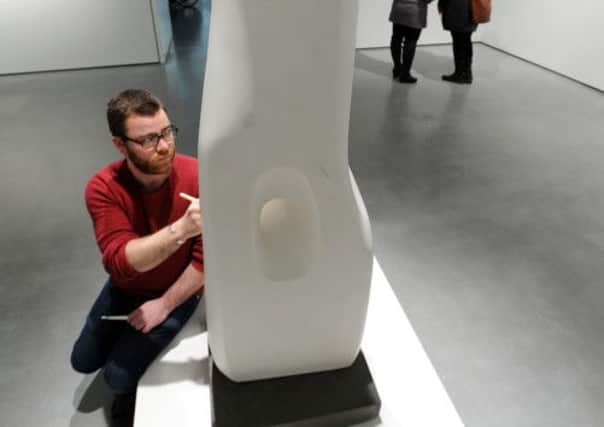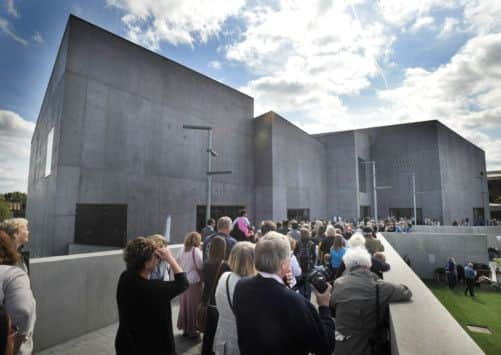Behind the scenes at the Hepworth Wakefield


JUDGING by the noise they’re making, the youngsters in the playroom are having a whale of a time.
Some are drawing or making objects out of felt, others are sculpting creatures conjured from their fertile imaginations. It’s colourful and boisterous but if it wasn’t for the fact that you knew you were in one, you could be forgiven for forgetting you were actually in a gallery.
Advertisement
Hide AdAdvertisement
Hide AdYou don’t have to travel too far back in time to remember the days when a visit to a museum or gallery meant trudging round seemingly endless gloomy rooms looking at paintings or ancient objects behind glass walls, accompanied by the obligatory signs saying “don’t touch.”


Thankfully such experiences have largely become a thing of the past with places like The Hepworth Wakefield transforming the way we use galleries and exhibition spaces. Since opening in May 2011, The Hepworth has seen more than 830,950 visitors pour through its doors during which time it has added to Yorkshire’s embarrassment of cultural riches and boosted Wakefield’s profile.
Earlier this month it was named as one of the 10 finalists for the prestigious Art Fund Prize for Museum of the Year 2013. The gallery narrowly missed out on the £100,000 prize last year and hopes to go one better this time around when the winner is announced in London in June.
Striking in appearance, The Hepworth is just as bold on the inside. As well as boasting impressive collections and high-profile exhibitions it encourages young people and families to use the gallery, with visitors able to try their hand at everything from sculpting to sewing.
Advertisement
Hide AdAdvertisement
Hide AdEmma Spencer is a freelance artist who works on several of the workshops run by the Hepworth, including those for schools and families, as well as toddler sessions and outreach programmes.
In the family sessions they do everything from felt-making and print-making, to modelling with clay and metal sculpting. “We try and make the galleries come alive and encourage families to work together, because if people are involved and they’re learning then that’s a much more powerful experience than if they’re just coming in and looking at something.”
And people travel from far and wide to get involved. “We get families coming from all over the place, today I’ve had people in from Sheffield and Doncaster as well as Wakefield, and on the way in on the train I met a family who were coming here from Huddersfield.”
Emma takes pleasure from seeing children and their parents, or grandparents, learning together. “I have three children myself and it’s just that magic of seeing people making things together and realising that art galleries are actually really good for families.”
Advertisement
Hide AdAdvertisement
Hide AdAs well as being at the heart of the local community, the gallery also has some impressive collections, including rare works by Barbara Hepworth herself, and plays host to exhibitions by contemporary artists.
Matt Jamieson is a gallery technician involved in the practical side of running the gallery such as installing the art works and sculptures and helping to plan future shows. He says that each exhibition requires months of preparation. “The last show we did with Linder Sterling we had to produce these black monolithic light boxes that hold illuminated collages and we worked on that particular show for about six months.”
Each new exhibition throws up a different challenge. “With a contemporary art programme there are always challenges because you’re working with artists who are working with new ideas and new technologies so with every show there are new surprises. In our last show there were three artists involved so with Alice Channer there was a lot of sculptural work which involved lots of different fixings, stuff you don’t normally see but which keeps the work in place.”
Matt says he and his fellow technicians are still learning about the gallery. “We’re still learning about how the sound travels throughout all the different spaces here.
Advertisement
Hide AdAdvertisement
Hide Ad“We have a show coming up with Haroon Mirza and there will be a sound element to that. In the past we’ve had other works where we’ve used curtains to block the sound and this hasn’t worked as well as we might have liked so we’ve been trying out different things. But because we’ve only been exhibiting for a year-and-a-half we’re still working out these little nuances.”
Part of his job is to liaise with the artists which means he has to be part technician, part diplomat at times. “You get different personalities as you do in any job and sometimes it can be quite intense because each artist has a different way of working. Some are quite relaxed while others want to be there for every moment their work’s being installed.”
He finds the combination of the old and the new in the gallery creates a fascinating contrast. “The great thing for me is we have a contemporary programme alongside works by Barbara Hepworth from the last 100 years, which gives you different things to think about.
“Works of a certain age need to be looked after in a certain way and some end up being put in a perspex box or cordoned off because of their delicate nature and as time goes on we have to think more and more about the care of the artworks and how they’re looked after.”
Advertisement
Hide AdAdvertisement
Hide AdIt’s just another aspect to a job that continues to fascinate him. “We’re still seeing how the public use the space and how best to present works. It’s a learning process and that’s what makes it really interesting for all of us.”
As well as hoping to be crowned “museum of the year”, The Hepworth is also in the running to win the Clore Award for Learning, an additional £10,000 prize that recognises achievements in learning programmes in British museums.
Natalie Walton, head of learning at The Hepworth, says education is at the heart of what they do. “We have everything from toddler groups to adult lifelong learning workshops.”
They also have a youth panel that organises events for young people aged between 16 and 25 and work with young people that aren’t in education and are struggling to find jobs. “What’s important for us is not only to show that we’re a fantastic gallery but that we also have some great resources here.”
Advertisement
Hide AdAdvertisement
Hide AdPart of the gallery’s focus is to engage the local community and support regeneration in the area and one of its main aims is to get young people interested and involved in art and culture.
“We want to raise the aspirations of young people. We do have high levels of youth unemployment in Wakefield and we want to show them roles models and ways forward, because Barbara Hepworth herself was a local resident and someone who went on to do incredible things.
“It’s not necessarily about turning them into artists but so they have creative skills for life which supports employment.”
A key element of her role is working out how the gallery can fit in with the government’s education framework. “We have a network of local teachers and artists who meet up to share ideas and we’re doing a lot of work to make sure the arts are still part of the curriculum in 2014 and I’m looking at programmes that marry up those policies and reforms with what we do,” she says.
Advertisement
Hide AdAdvertisement
Hide Ad“We get art teachers coming here with their classes, but a maths teacher won’t necessarily see the connection so we’re very much thinking about how we can get through to maths teachers and science teachers to show the different ways they can use the gallery, because it’s important that art is never lost in the curriculum and is always there as a foundation to learning.”
The question of funding has become a thorny issue in arts circles recently with many organisations being affected by spending cuts, and because of this tougher climate fundraising and promoting the gallery have become even more important.
“It is more challenging, there are smaller pots and more people going for them. But we’re very lucky at The Hepworth to have the profile we do and the good work we’ve done in such a short period of time does instil foundations and trusts with a lot of confidence in what we can do.”
She says galleries and museums have had to change the way they operate now. “At one time it was a case of opening your doors and seeing who came through, but we think carefully about who we’re putting an exhibition on for and how we get people interested, because you need to understand your audience,” she says.
Advertisement
Hide AdAdvertisement
Hide Ad“The environment around us is changing so much, both the funding situation and society, and it’s about how we respond to this.”
But she has no doubt that places like The Hepworth have a big role to play. “If we start introducing young people to galleries that means they’re exposed to art from a very young age. We’re particularly focused on families because it gets parents and children working and sharing together. Not only that but it is a great environment where you can use your imagination, nothing is right and nothing is wrong and where else can you get that in life?”
The Art Fund Prize Museum of the Year Award 2013 will be announced on June 4.
Museum of the year 2013
Since opening in May, 2011, The Hepworth Wakefield has had more than 830,950 visitors.
Advertisement
Hide AdAdvertisement
Hide AdThe gallery is one of the 10 finalists for the prestigious Art Fund Prize for Museum of the Year 2013.
The nine other finalists for the Museum of the Year award are: The BALTIC Centre for Contemporary Art, (Gateshead), The Beaney (Canterbury), Dulwich Picture Gallery, (London), Horniman Museum & Gardens, (London), Kelvingrove Museum and Art Gallery, (Glasgow), Museum of Archeology & Anthropology, (Cambridge), Narberth Museum, (Wales), Preston Park Museum, (Stockton-on-Tees) and the William Morris Gallery, (London).